What is A Good ‘OOO’ Message? Use These Templates and Examples to Make Yours Great
Out of office email messages are automated messages that let people who email you know you’re away, and tell them three key things they need to know in your absence –
- The reason.
- When you’re back.
- Who can help in the meantime.
Use them effectively, and your OOO messages will help move your business on, without you doing anything. Picking up emails on your phone when you’re out and about is all well and good if you have time. But if you don’t reply, they pile up. So, get your out of office message right, and it really can say it all for you.
Why Do We Need Out of Office Messages?
We’ll look at some specific OOO message templates in a moment. First, a quick reminder about why they’re so useful.
The average white-collar worker sends around 40 emails a day. You can’t reply promptly when you aren’t there. Hence the importance of OOO messages. You want things going smoothly while you’re away, and to avoid people getting impatient. Colleagues, line managers, clients, everyone deserves a prompt response and to know who to turn to in your absence, or when urgent action’s required, make other plans. Also with OOO’s in place, colleagues won’t have to go into your inbox. Plus you’ll have fewer emails to come back to.

When Do You Need Out of Office Messages?
Typical situations calling for effective out of office messages include:
- Annual leave/holiday
- Sick leave
- Maternity leave
- Other leave
- Away on business for an extended period
- Leaving the company
You should also consider using out of office messages for shorter periods:
- Away all-day
- In a meeting
To be professional, you need to update your out of office email messages regularly, just like your voicemail ones.
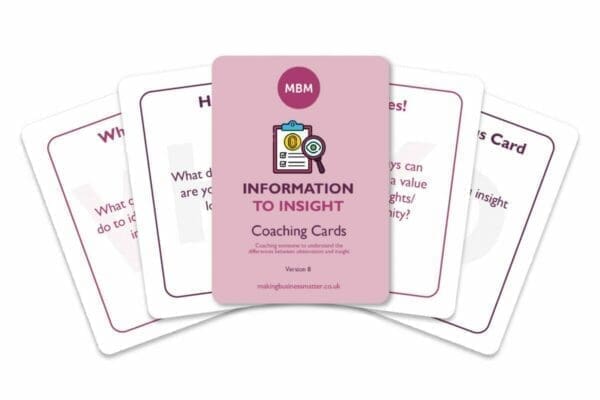
>> Information to Insight Coaching Cards <<
>> Access on Amazon <<
How To Write an Out of Office Message
All in all, it’s best to keep your messages as simple as possible. Follow this sequence:
Sticky Learning ® is 7 times more effective than 1-day training courses. Plus, you will get a Chain of Evidence proving your Return on Investment. Discover soft skills training that changes behaviours long term.

1. Begin With a Friendly Greeting:
Your reply is going to a wide audience, so keep it pleasant but business-like, in the language you normally use in emails. Whether you’re a formal sort of company, or you’re more informal, use your usual tone of voice.
2. Tell Them You’re Out of the Office, and Why:
You’re interacting with human beings with feelings. Giving the reason you’re away will prompt their empathy, so it’s good to say it.
3. Give the Dates When You Won’t Be Available:
This is the most important information in your message, so people can decide what to do in your absence. It’ll also stop them from emailing you again while you’re away and filling your inbox with even more emails.
4. Say When You’ll Reply Properly:
To be fair, you’re not likely to reply to everyone immediately after you return, nor should they expect you to! Keep it friendly, say you’ll answer their email as soon as you can when you’re back.
5. Tell Them Who to Contact in Your Absence:
Give the details – email address and mobile number – of at least one person people can contact while you’re away. This person should know enough about your work to take the right action, whether they handle it personally or find someone who can. But remember before you go, to make sure this person knows you’re giving out their details like this!
Here Are Some Common Out of Office Message Examples.
1. A Simple Out of Office Message:
“Thanks for emailing me. I’m going to be out of the office from [date to date], with limited access to email. If your message is urgent, please contact [name, email and mobile.] Otherwise, I’ll respond to your email as soon as I can on my return.”
This will work for anyone in any role, however long you’re gone for.
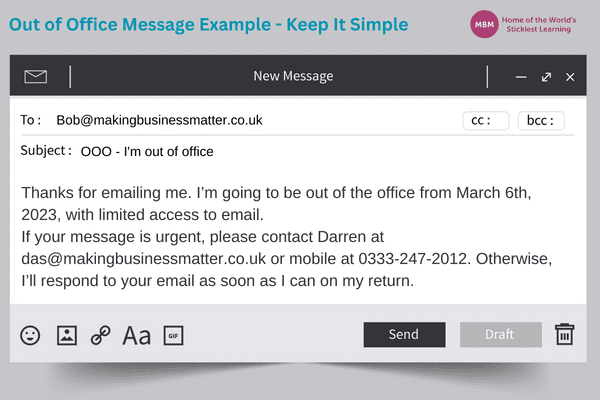
2. Out of Office for One Day:
If you’re only going to be away for a single day or part of it, and you typically check your email on your travels, you don’t need a long message. Try something like this:
“Thanks for emailing me. I’ll be away from my desk for a meeting from [time you leave] to [time you return] today, [current date.] I won’t be able to access my emails until I’m back, so if you need something urgent, please contact [name of colleague] at [contact information.]”
You’ll probably be dipping into your emails on your phone. But this makes it clear you don’t want to be disturbed unless it’s mega urgent. In which case your colleagues will be able to reach you.

3. Enquiry Generation and Marketing:
“Thanks for emailing me. I’m going to be out of the office from [date] to [date], with limited access to email. In the meantime, EITHER have you seen our new [whatever] OR have you signed up for our [event, email newsletter etc]?”
Follow this with a sentence saying why what you’re offering is beneficial. Then say here’s a link to find out more/download it.
“If your message is urgent, please contact [name, email and mobile.] Otherwise, I’ll respond to your email as soon as I can.”
This format will let people know you’re out, AND generate enquiries or leads. It won’t work for existing clients or customers but should bring in some enquiries.
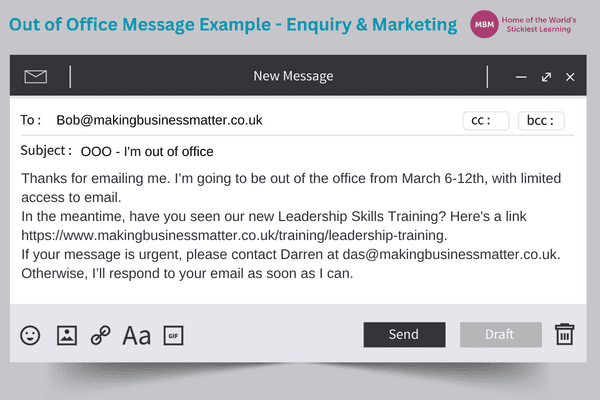
4. Hard Sell:
“Thanks for emailing me. I’m going to be out of the office from [date] to [date], with limited access to email. If you’re emailing me about our xxxxx [thing you’re selling], you can find out more here [link.] Or if you’d like to know what [packages, deals] we still have available, please contact [name, email and mobile.] Otherwise, I’ll respond to your email as soon as I can.”

5. Away at a Trade Show or Conference:
“Thanks for emailing me. I’m away from the office, attending [event name] from [date] to [date.] If you’re going to the event, EITHER I look forward to seeing you there and having a chat, OR [as relevant] why not come and see us on stand XXXX, it’ll be great to see you. You can contact me at the event on [mobile.] In my absence, please contact [name, email and mobile.] Otherwise, I’ll respond to your email when I’m back.”
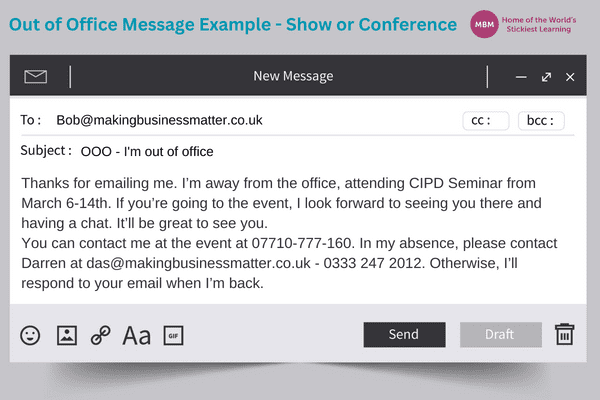
6. Highlighting Social Media:
“Thanks for emailing me. I’m going to be out of the office from [date to date], with limited access to email. You can find me on LinkedIn at [link.] I’ll be happy to connect, and engage with you directly if I’m around. You can also find our latest company news on our website at [link.] If your message is urgent, please contact [name, email and mobile.] Otherwise, I’ll respond to your email as soon as I can on my return.”
If you’re big on LinkedIn and other social media, this is a good way to draw people’s attention to it and encourage them to connect with you.
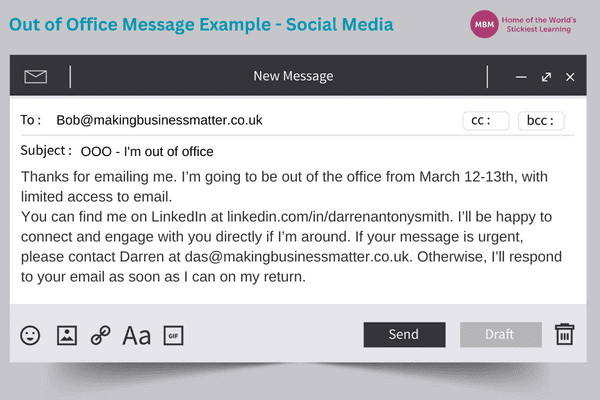
7. Sick Leave:
“Hi, I am currently on sick leave, so will not be responding to any emails for the time being. Please contact [name at email address and phone number], who will be happy to help while I’m away.”
Chances are, you will be setting this up for an unfortunate colleague, which can be awkward when you don’t know when they’ll return. It’s short and to the point.

8. Holiday:
You can be a bit more creative with these messages, but you’ve still got to pitch it right:
“Hi! I’m currently away from the office, taking time out to [do whatever] in [location.] During this time, I will have limited access to emails, but I’ll read your message and respond when I’m back again on [date.] In the meantime, if you would like to speak to one of the team before that, please reach out to [name, email and mobile], who will be happy to help.”
If your business has an informal culture, you can also include an image of where you’re going. But bear in mind, that your message still needs to be professional.
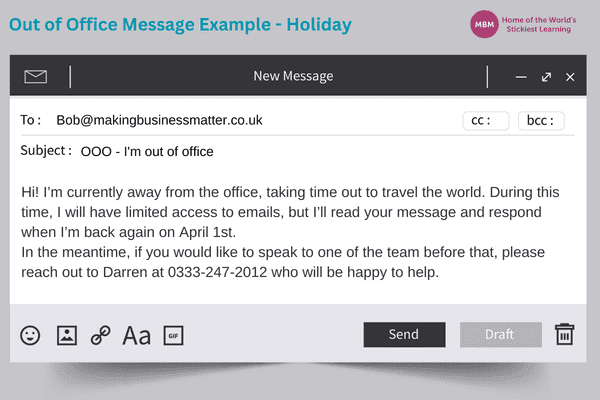
9. I’ve Left:
“Thanks for emailing me. I have now left the business. For all enquiries please contact [name, email and mobile.]”
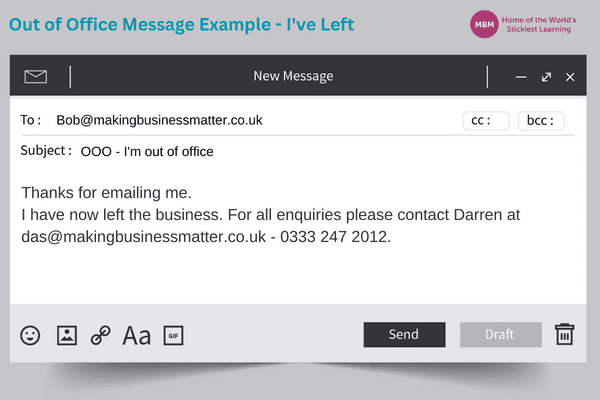
What Is a Professional Out of Office Message?
This OOO message covers much the same ground as the others. The difference is, that the tone of voice is more serious. However, the last sentence adds some much-needed warmth and shows you’re a human being:
“I am currently out of the office and will not be able to respond to emails until (date of return.) If your matter is urgent, please contact (name and contact information for alternative point of contact.) Otherwise, I will get back to you as soon as possible upon my return. Thanks for your understanding!”
How Do You Manage OOO Messages in Outlook?
Support.microsoft.com says only certain types of accounts support the Automatic Replies (Out Of Office) feature. If you’re using Outlook for your emails and you don’t see the Automatic Replies button, your email account doesn’t support this feature. However, if you leave Outlook running while you’re away, you can use rules to reply to your email messages automatically. Rules also allow you to forward emails to another account, mark messages as read, or move them to a folder automatically. For more information on working with rules, see the section at Support.microsoft.com entitled ‘Manage email messages by using rules.’
What Are Some Examples of OOO Messages In Outlook?
- Basic OOO message: Hello, I am out of the office from [leave date] to [return date] with limited/no access to emails.
- Vacation message: Hello, I am currently out of the office on vacation. I will reply to your message when I return on [return date.]
- Internal message: Hi team, I am out of the office from [leave date] to [return date] for [reason.] For urgent matters, please contact [name] at [email/phone.]
- Out of reach message: Hello, I am out of reach until [return date] with no access to email. If you need immediate assistance, please call [phone number.]
- Maternity/paternity leave message: Hello, I am on maternity/paternity leave until [return date.] For urgent matters, please contact [name] at [email/phone.]
- Medical leave message: Hello, I am on medical leave until [return date.] For urgent matters, please contact [name] at [email/phone.]
- Conference/event message: Hello, I am attending a conference/event from [leave date] to [return date.] I will have limited access to email during this time. For urgent matters, please contact [name] at [email/phone.]
- Holiday message: Greetings! I am out of the office for the holidays from [leave date] to [return date.] I will respond to your message when I return. Happy holidays!
OOO Messages with Gmail
Gmail Help also offers different ways of doing this with a computer, Android, iPhone, or iPad. It’s also about turning on Out of Office AutoReply, filling in the date range, subject and message and selecting who you want to get your out of office messages. Again, Gmail Help offers plenty of advice.
And Finally: What is the Best Out of Office Message?
The ideal out of office email message is brief and to the point:
“Thank you for your message. I will be away from the office until [return date] for [general reason.] If you require immediate assistance, please contact [name of colleague] at [contact information.] Otherwise, I’ll get back to you after I return.”

All the out of office message examples we’ve given earlier are based on these principles:
- Let people with work-related requests or questions get the information instantly, and know who to turn to in your absence.
- Remember, you’re dealing with a wide audience. Keep the wording as clear as possible.
- Get the tone right: Use the same tone of voice you do in your emails. Whether you’re a formal sort of business, or you’re more informal, be consistent.
- Always check your messages for spelling, grammar, and mistakes. Reading your message aloud before saving it, could save embarrassment later. Out of office messages with unintentional mistakes can be hilarious. But it’s no joke if they’re coming from YOUR email address.
Here’s one more thing. If you forget to update your email out of office message before you go, it’s not the end of the world. Get your tech sorted out, and you can update your automatic replies from your mobile. Or your colleagues can do it. Businesses will have their own procedures for all this – or if not, get proper advice from someone who knows this stuff.
Take care, and remember these tips to stay in touch, even when you’re not!
Updated: October 2023 by Charles Smith




